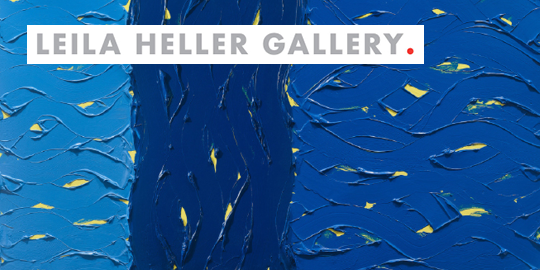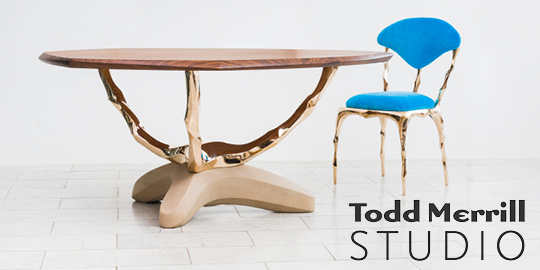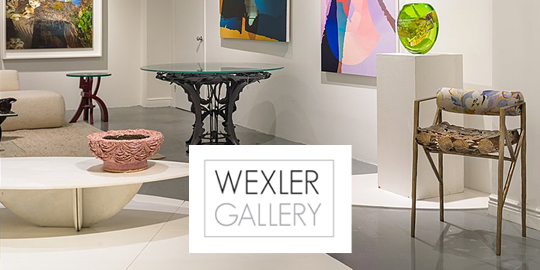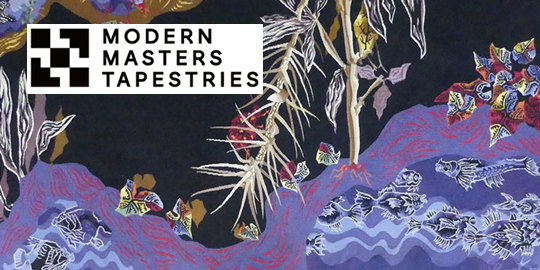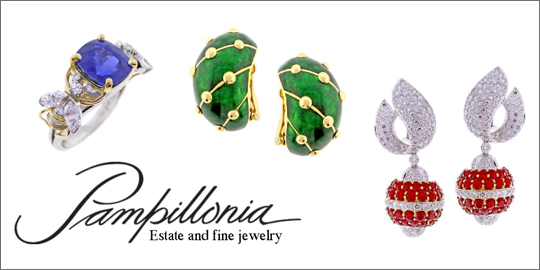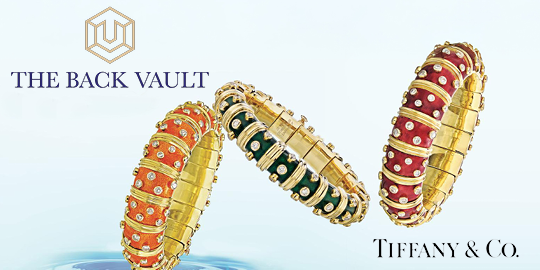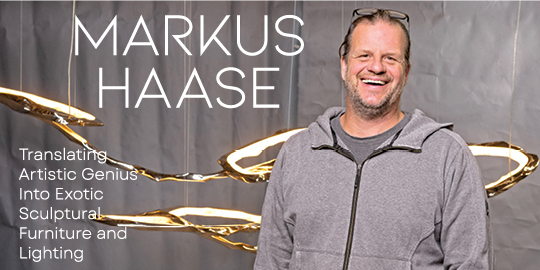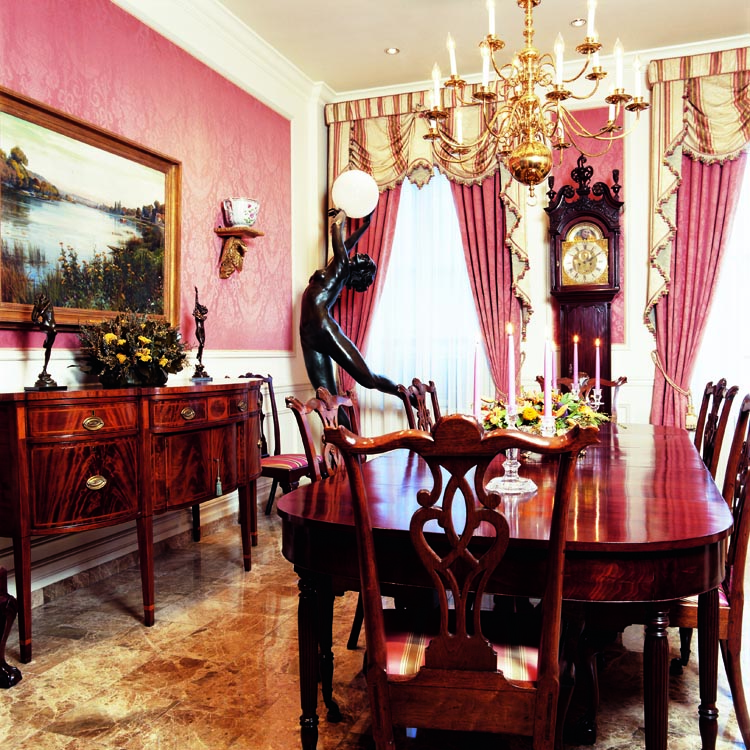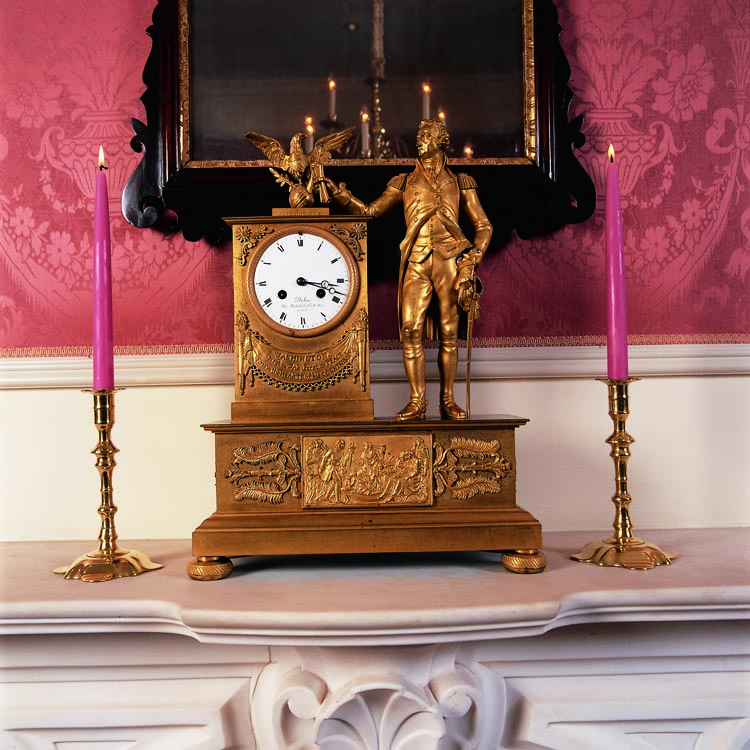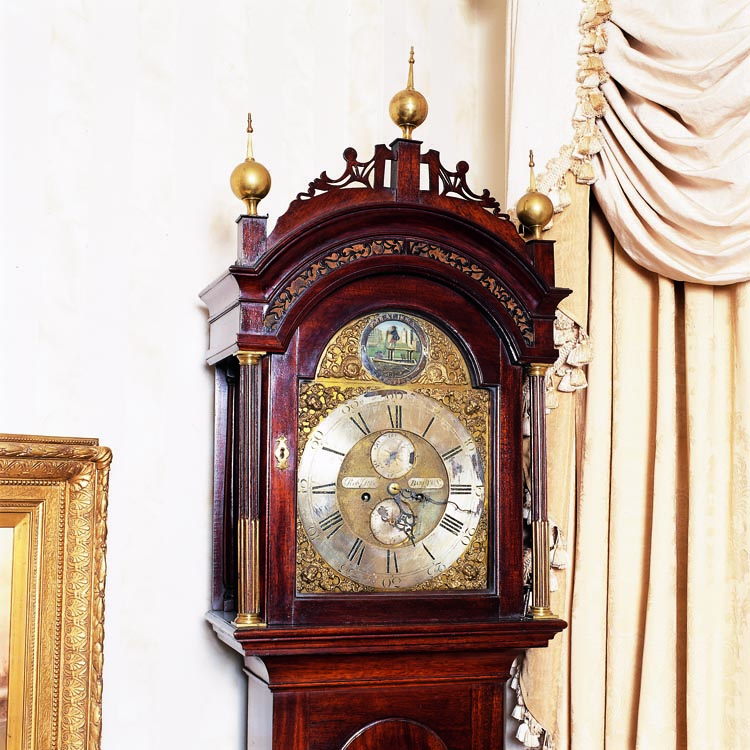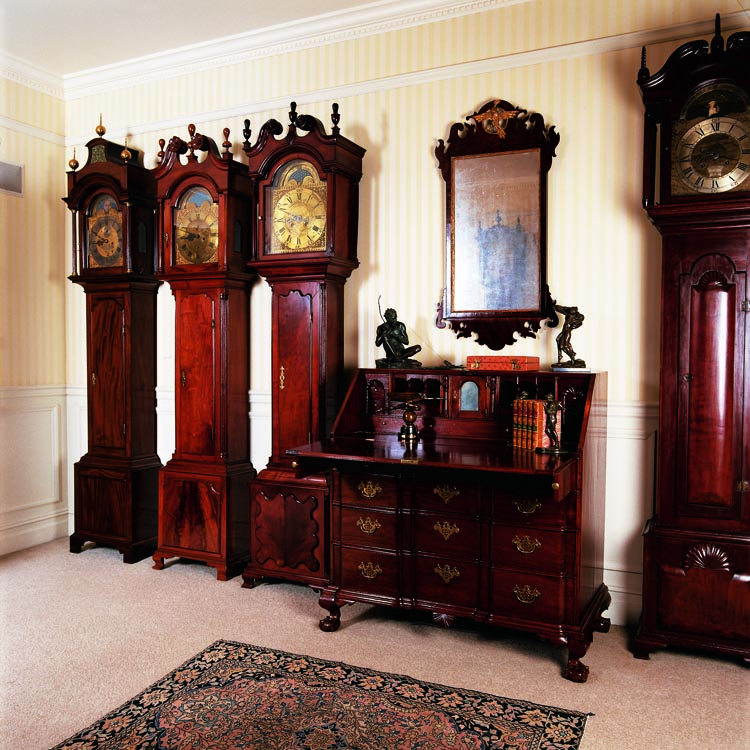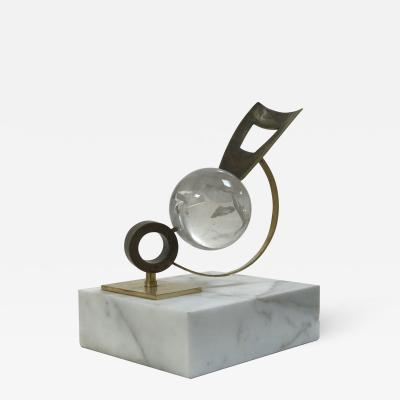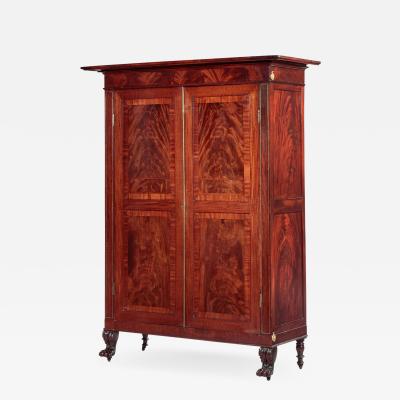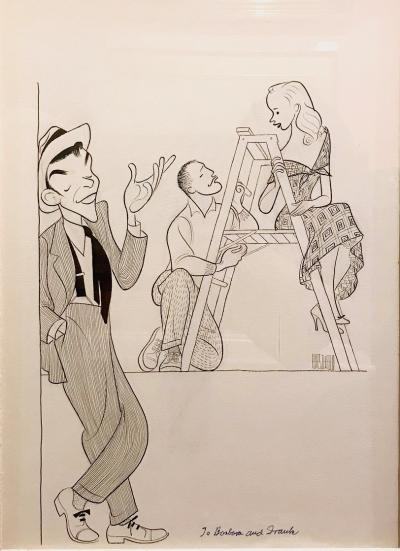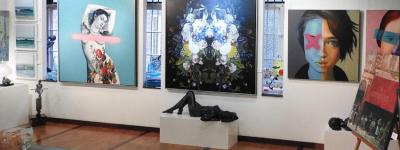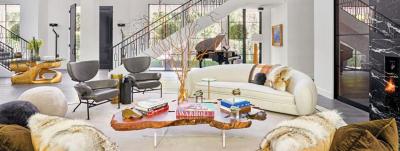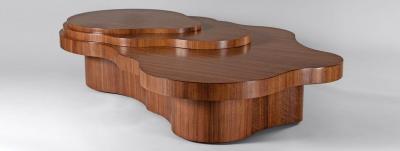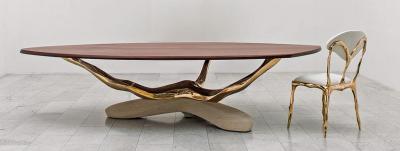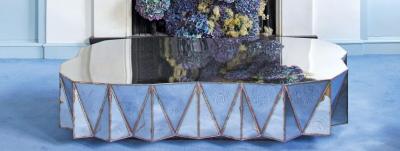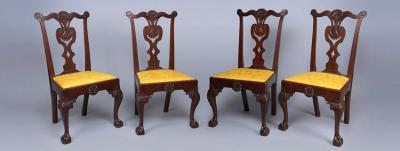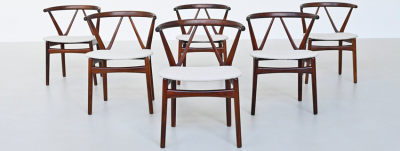Time Stands Still: The Home & Collection of Frank and Kristin Hohmann.

- A block-and-shell kneehole desk, ca. 1768–1779, attributed to Edmund Townsend (1736–1811) and Daniel Goddard (1747–1779) of Newport, graces the paneled second-floor stair hall.3 As with documented examples by Townsend and his nephew Daniel Goddard, there are eleven lobes carved into the shells, rather than the ten seen on the work of other Newport craftsmen. The additional lobe on each shell creates a more visually dynamic façade, and when combined with the blocked drawers, astragal door, and volute-carved feet, the result is visually stunning.
Frishmuth’s The Dancers stands on the desk, below John Joseph Enneking’s (1841–1916) Venice at Midday. Enneking was among the most prominent American impressionists. He made many trips abroad, painting with, among others, Monet, Pissarro, and Renoir. In the early 1870s, Enneking traveled to Venice, where he painted this scene in the brown and green Barbizon palette of Corot and Millet. “This is one of my favorite paintings,” says Frank. “Not only is it an emotive landscape, but Kristin and I have stayed in the balcony room of one of the hotels pictured in this scene; we couldn’t resist the painting when it became available.”
To the side of this grouping is an early tall case clock, ca. 1740, with a lunar calendar dial signed by Peter Stretch (d. 1746). Stretch was Philadelphia’s most important early clockmaker. His name appears in cabinetmaker John Head’s account book. On Stretch’s death, John Wood Sr. purchased his shop. Among its features are the turned ball feet, holdovers from the William and Mary period, and the sarcophagus dome-top hood with elaborate blind fretwork.
People have long been fascinated with clocks—be it their appealing decorative brass or painted faces, the aesthetics of the case, or the intricacies of the timepiece mechanisms. There is something soothing about the sounds of a clock—the steady rhythm of the pendulum, the chimes heard on the hour, and with musical clocks, a roster of tunes. The dials offer dynamic visuals as well, with the movement of the hands and often, additional components such as the rocking of a ship or the shifting of moon phases.
Frank Hohmann and his wife, Kristin, are among those who are drawn to tall case clocks. With twenty-four placed throughout the rooms of their five-story Manhattan townhouse, Frank admits, “We have to limit ourselves, otherwise there would be no space left and the clocks would be filling the street; fortunately, Kristin shares this collecting interest.” Though the number of clocks in the Hohmanns’ collection may seem extensive, each one is carefully placed so as to achieve maximum visual effect, reflecting the historic tradition of tall clocks being prominently located in the home, signifying their importance.1
Frank began acquiring clocks in the late 1980s; and Kristin, since their marriage nine years ago, has joined him in this pursuit. When Frank began collecting, he was working with the investment firm of Donaldson, Lufkin, & Jenrette. Through his friendship with Richard Jenrette, who amassed an impressive corporate collection, Frank developed an interest in antiques. He became particularly enthralled with tall clocks, though he has also acquired a number of shelf, bracket, and lantern clocks along with other notable American furnishings. Over the years, he has had to become disciplined in his choices, either turning down clocks or upgrading, depending on what was presented. Where, at one point, there were Federal-period Aaron Willard and Solomon Parke painted dial clocks in the collection, there is now only one Federal tall clock; a moon phase dial clock signed by Benjamin Morris of Bucks County, Pa., ca. 1780. “I grew up in Morrisville, and the clock was made close to where I was raised, so I decided to keep it.” Adds Frank, “If there is a focus to our collection, it is brass dial clocks. I feel that the brass surfaces are a better fit with the furniture in our collection than the painted dials, and, in general, I prefer the casework of these mid-eighteenth century clocks.”
The numerous tall clocks purchased over the years—including those with dials signed by Peter Stretch, John Wood, Joseph Wills, Joseph Godshalk, Peter Lupp, Edward Spalding, Robert Pope, Daniel Burnap, and Duncan Beard—were all made along the eastern seaboard between Boston and Maryland. Frank’s reason for owning clocks from such varied origins is based purely in aesthetics. “I don’t focus on regionalism,” he says, “I am interested more in form and rarity.”
Like anyone with a passion for objects, Frank has spent years visiting museum collections, talking with curators and dealers, and reading books. Throughout this time, he has been frustrated by the lack of publications that focus on brass dial clocks. As a retired executive, Frank now has the time to devote to rectifying this concern, and has begun compiling material for a book in which brass dial clocks are the sole topic. He plans to record and document all known examples and provide scholarly information that will be useful to curators and collectors alike.
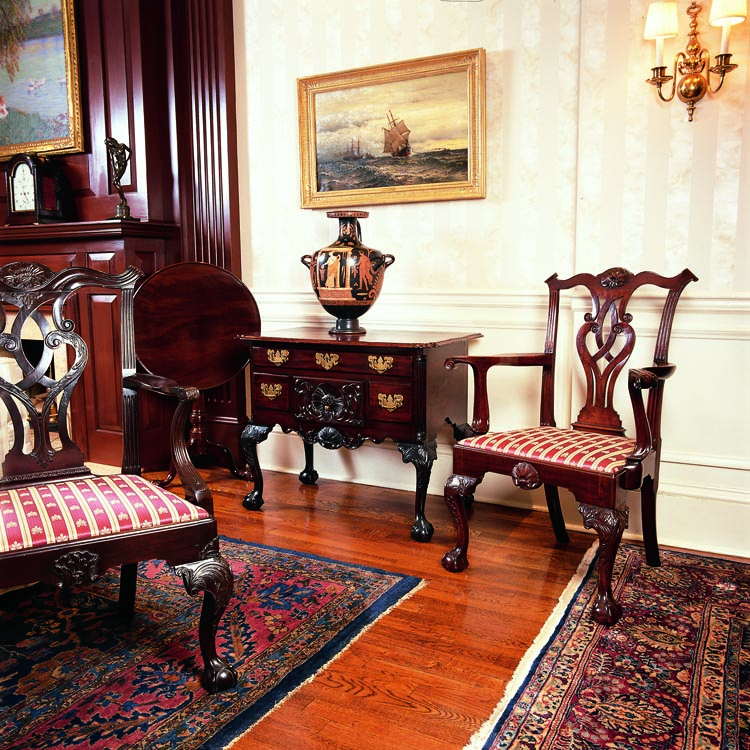
- Across from the Philadelphia high chest is its matching dressing table and an armchair, all of which were purchased at different occasions. “I was tenaciously seeking a side chair to match the high chest and dressing table,” says Frank. “I was shown an armchair and was ecstatic. As far as I am aware, it is the only matching high chest, dressing table, armchair combination. There is no doubt in my mind that they are all carved by the same hand and were originally made as a suite.”
Against the mantel is a Philadelphia tilt-top candlestand, and in the foreground is another elaborately carved Philadelphia armchair. The Apulian red-figure Greek hydra vase (ca. 340 b.c.) is attributed to the Copenhagen Painter. It is one of a pair in the room. M.F.H. de Haas’s (1822– 1895) Off New England Coast hangs over the dressing table. This grouping, combined with Frishmuth’s Ecstasy on the corner of the mantel, epitomizes the Hohmanns’ eclectic, yet harmonious collecting interests—focusing on beauty of form rather than time period.
While Frank’s scholarly pursuits may have begun with tall clocks, they extend to other areas of the collection. Another of his passions is the bronze sculpture of Harriet Whitney Frishmuth (active 1910–1940), on whom he and several scholars are collaborating on a catalogue raisonné. A Philadelphian by birth, Frishmuth received her initial training overseas, studying under such notables as Auguste Rodin (1840–1917) when in Paris. After her return to the States, she studied at the Art Students League in New York and became a member of, among other venerable associations, the National Sculpture Society, the National Arts Club, and the National Academy of Design. Her work was highly acclaimed, and she exhibited at numerous venues, including the Pennsylvania Academy of Fine Arts, the Paris Salon, and the Panama-Pacific Exposition of 1915 held in San Francisco, a winning entry from which—Child with Dolphin—is in the Hohmanns’ guest bedroom.
Frishmuth is most famous for sculpting spirited young women, examples of which can be seen in several rooms in the Hohmanns’ townhouse. Frank and Kristin are drawn to the playful aspects of Frishmuth’s sculpture. “Our daughter adores them as well,” says Kristin, “at times swirling about the rooms in imitation of the sculptures.” The Hohmanns also have examples of some of Frishmuth’s rarer forms, which include eagles and a few sculptures of men.
Of the approximately 150 works Frishmuth is known to have produced, the Hohmanns own nearly forty—from small table-top studies to an enormous sundial in the front yard. Pursuing her works for over twelve years, Frank admits, “I am an incurable collector when it comes to Frishmuths. Once Kristin and I got past ten, it seemed as if it was a challenge as to how many we could amass. They are absolutely engaging, with a tremendous spirit of vitality.”
In addition to the sculptures, clocks, and other fine antiques throughout the house, the eclecticism of this collection is furthered by the nineteenth- and early-twentieth-century American paintings that line the stairways and hang above the furniture—works by Guy Carleton Wiggins, Jasper Francis Cropsey, John Joseph Enneking, M.F.H. de Haas, Arthur Clifton Goodwin, and Edward Dufner, among them. “We like the way the later paintings accent the earlier furnishings, and they provide a nice transition to the sculptures. And even though they generally represent different centuries,” says Frank, “they blend together very well.” “The choice of subject matter is what we think makes it work,” notes Kristin. “We are careful to select paintings that are of outdoor scenes or still life works; those that have the essence of naturalism, which play with the design elements of the furniture.”
“At this point,” says Frank, “the collection, and effectively the furnishing of the house, is complete. Going forward we will focus on refining and upgrading the collection where possible.”
1. Tall clocks have held a place of prominence in the home since their inception in the seventeenth century. Into the early nineteenth century, probate inventories continued to list tall clocks, along with silver and textiles, as the most valuable of household items. With industrialization widespread by the mid-nineteenth century, tall clocks were romantically seen as a connection to simpler times, as evidenced in Longfellow’s The Old Clock on the Stairs of 1856 and Henry C. Work’s Grandfather’s Clock, one of the two most popular folk songs of 1876.
2. Morrison H. Heckscher, Early American Furniture in the Metropolitan Museum of Art
(New York: The Metropolitan Museum of Art, 1985), no. 198, 306–307.
3. As with most of the Hohmanns’ collection, this desk was purchased at auction
in consultation with a leading dealer, in this instance, C. L. Prickett. For further
discussion on this desk, see Christie’s, The Collection of Mr. and Mrs. Eddy Nicholson (January 27–28, 1995), lot 1090.
4. Other clocks from this group are in the State Department, the White House, the Met, Winterthur, and elsewhere. For more information, see Jonathan Snellenburg, “George Washington in Bronze,” in The Catalogue of Antiques & Fine Art (Winter, 2001): 198–203.
5. The Clifton/Carteret high chest is in the Chipstone Foundation. (See Eleanore Gadsden, “When Good Cabinetmakers Make Bad Furniture,” Chipstone Journal [2001], figs. 4–6.) The others are in the New-York Historical Society (see Helen Comstock, American Furniture [New York, 1962], p. 310), and in the Detroit Institute of Art.
6. The account book of John Johnston is in the Baker Library, Harvard University.
See Mabel M. Swan, “The Johnstons and the Reas—Japanners,” The Magazine Antiques (May, 1943): 212.
7. For a more thorough discussion, see Christie’s, Important Americana (October 12, 2001), lot 134.
I would like to extend my appreciation to Martha Willoughby, who has done extensive research on this collection, for providing additional information on several of the clocks and furnishings discusssed in this text.


